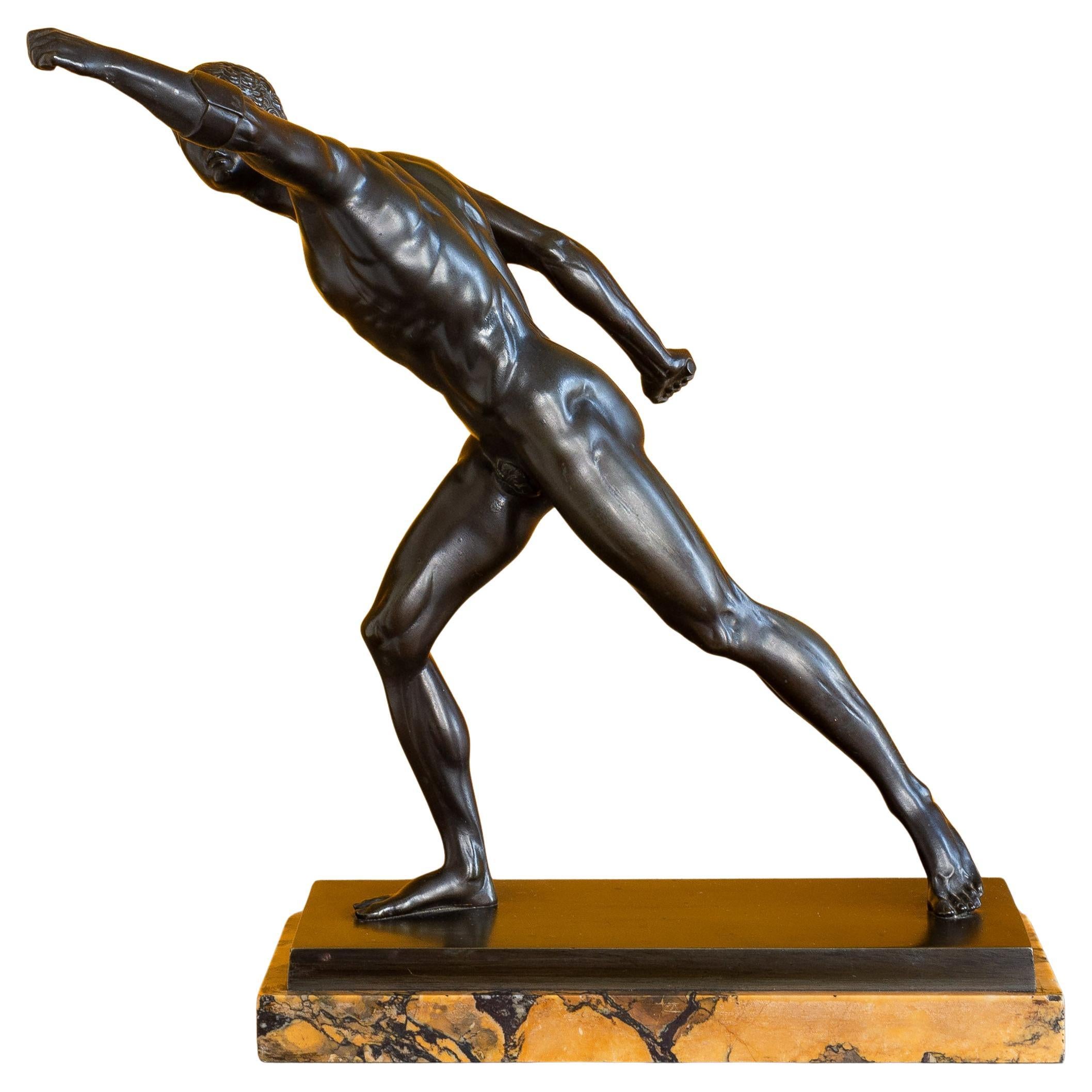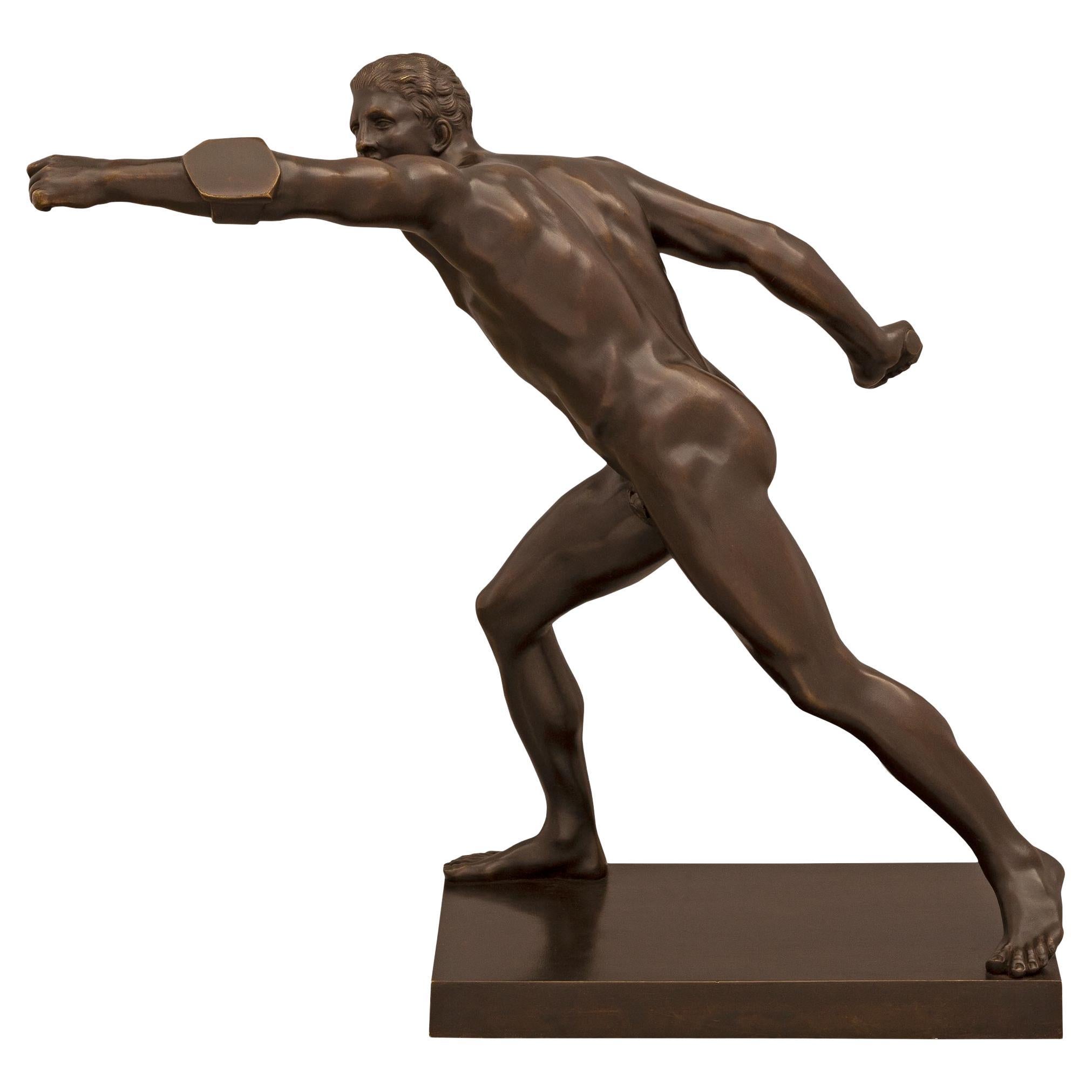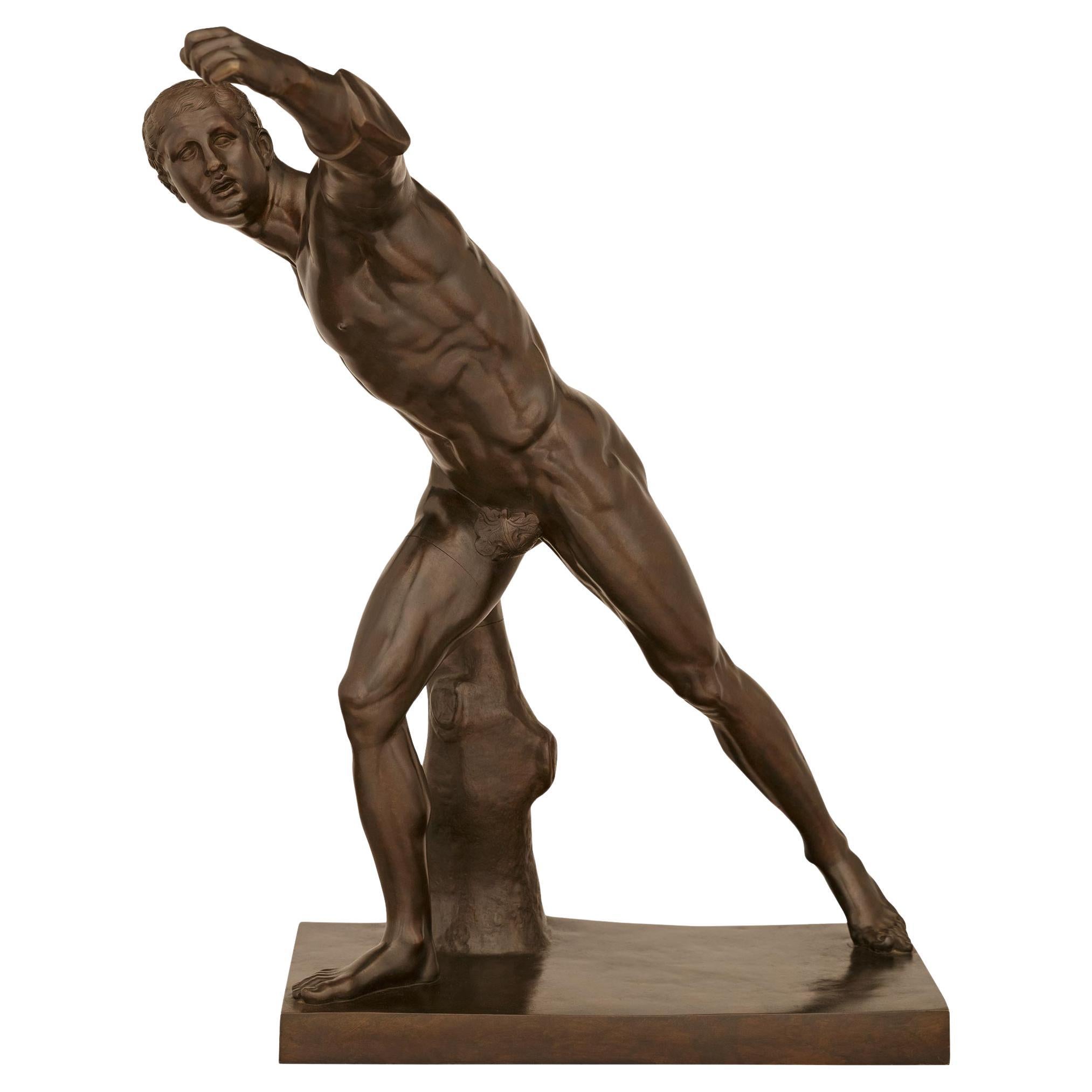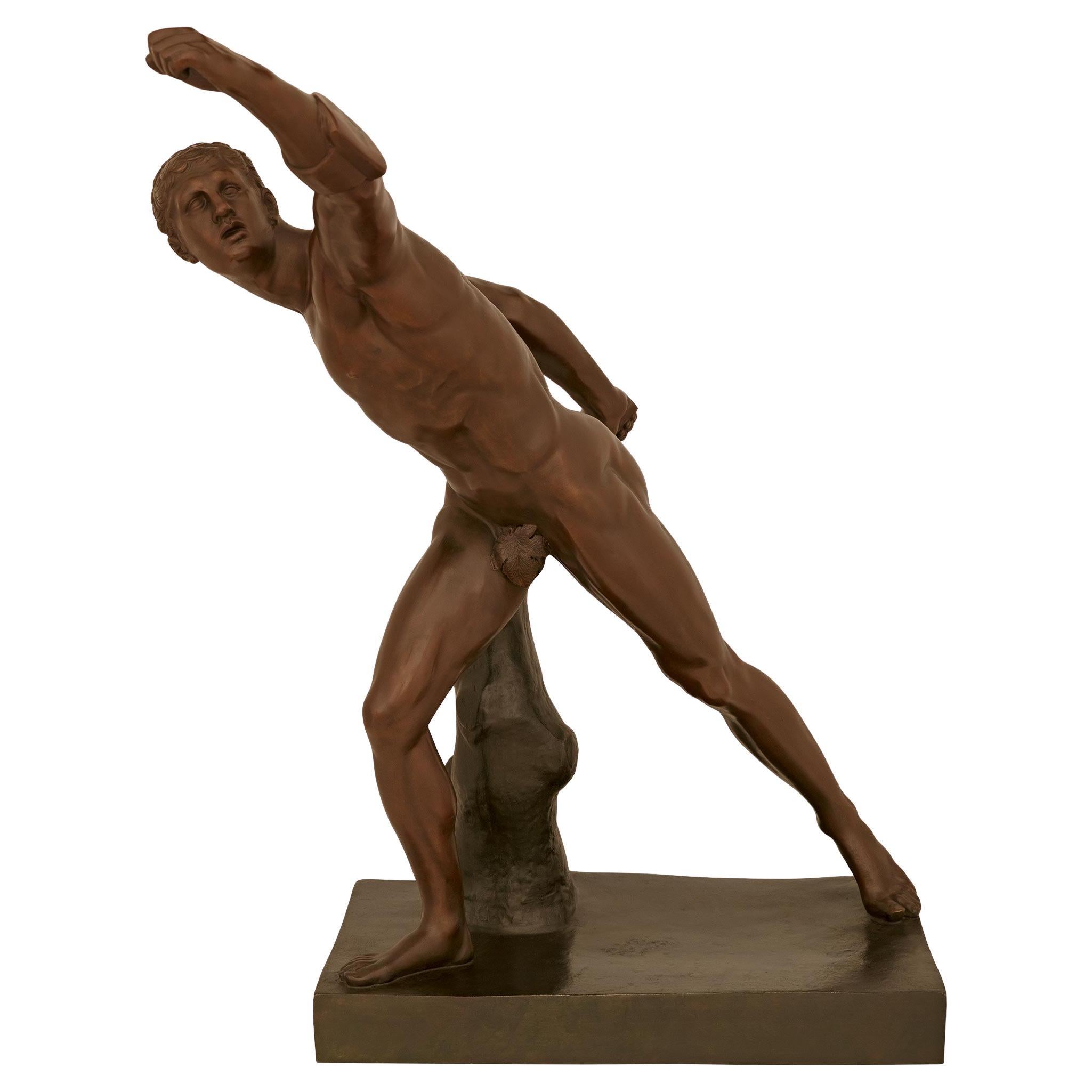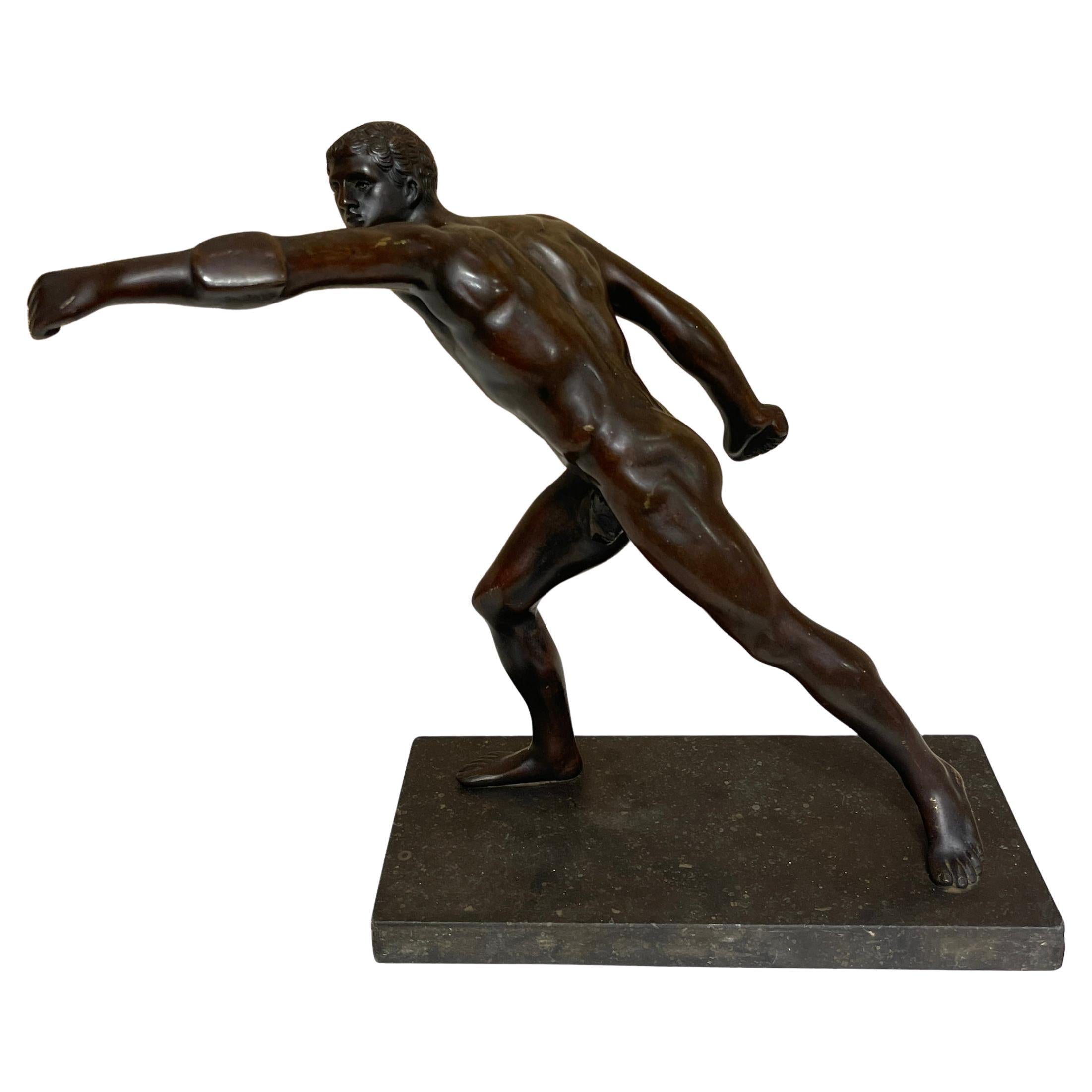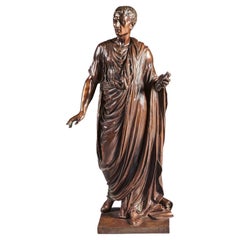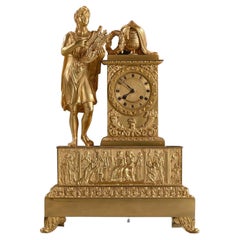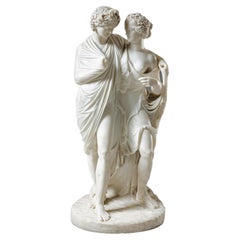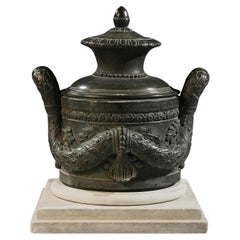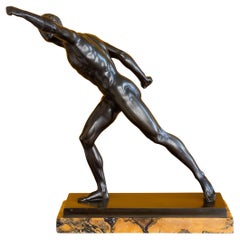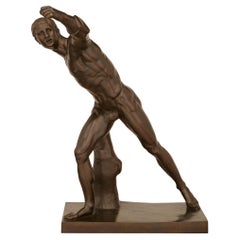Items Similar to 19th Century French Borghese Gladiator Bronze of Large Scale
Want more images or videos?
Request additional images or videos from the seller
1 of 8
19th Century French Borghese Gladiator Bronze of Large Scale
$4,791.96
£3,450
€4,067.78
CA$6,597.48
A$7,185.71
CHF 3,803.14
MX$87,919.41
NOK 47,060.90
SEK 44,422.60
DKK 30,361.02
About the Item
A finely cast large scale bronze of the Borghese Gladiator with exceptional patina
French c.1830-50
Due to the particularly fine casting of our piece, it seems likely that it is a French-made rather than Italian bronze though it is difficult to be entirely certain of its origin. Our piece has an exceptional patina and stands on a veneered marble base. The Borghese Gladiator quickly became one of the "must see" items on a wealthy visitor's Grand Tour with fine life size and smaller reductions of the piece in some of the most important houses in the world. One was the centrepiece of the sculpture collection at Wilton House, a house renowned for the quality of its sculptural holdings, until this was given to Sir Robeert Walpole who installed it at Houghton. Other versions are at Petworth, Knole and Windsor Castle and there are references showing that Thomas Jefferson imagined a copy of the piece as the ideal centrepiece for a sculpture gallery at Monticello.
The piece appears in a number of important paintings, a particularly evocative example being a work by Joseph Wright of Derby showing a group of connoisseurs inspecting a reduction of the figure on a table by candlelight.
Our bronze figure, of large size, depicts a swordsman, missing his sword as is the case with the original sculpture, probably in the process of defending himself against a mounted assailant. The original sculpture was incorrectly restored at one point and made to look like a gladiator with a small shield and sword which have since been removed but the gladiatorial name has stuck despite it being factually inaccurate.
The original bronze is signed by Agasias, son of Dositheus, of whom nothing else is known. It is believed to have been made around 100 BC in Ephesus. The piece once formed part of the collections in the Borghese Villa in Rome until it was sold, under some duress, to Napoleon Bonaparte in 1807. At that point it was removed to Paris and is now in the Louvre.
We are delighted to be able to offer this fine example.
- Dimensions:Height: 21.26 in (54 cm)Width: 19.69 in (50 cm)Depth: 11.82 in (30 cm)
- Materials and Techniques:
- Place of Origin:
- Period:
- Date of Manufacture:Circa 1830-50
- Condition:Wear consistent with age and use.
- Seller Location:Benington, GB
- Reference Number:Seller: 30411stDibs: LU1183241970562
About the Seller
5.0
Gold Seller
Premium sellers maintaining a 4.3+ rating and 24-hour response times
Established in 1969
1stDibs seller since 2015
128 sales on 1stDibs
Typical response time: 5 hours
Associations
LAPADA - The Association of Arts & Antiques DealersThe British Antique Dealers' Association
- ShippingRetrieving quote...Shipping from: Benington, United Kingdom
- Return Policy
Authenticity Guarantee
In the unlikely event there’s an issue with an item’s authenticity, contact us within 1 year for a full refund. DetailsMoney-Back Guarantee
If your item is not as described, is damaged in transit, or does not arrive, contact us within 7 days for a full refund. Details24-Hour Cancellation
You have a 24-hour grace period in which to reconsider your purchase, with no questions asked.Vetted Professional Sellers
Our world-class sellers must adhere to strict standards for service and quality, maintaining the integrity of our listings.Price-Match Guarantee
If you find that a seller listed the same item for a lower price elsewhere, we’ll match it.Trusted Global Delivery
Our best-in-class carrier network provides specialized shipping options worldwide, including custom delivery.More From This Seller
View AllFine Bronze Figure of a Roman Orator Probably Julius Cesar by Mathurin Moreau.
By Mathurin Moreau
Located in Benington, Herts
An Elegant Patinated Bronze Figure of a Roman Orator probably Julius Cesar by Mathurin Moreau 1822-1912, Signed Moreau Math Exposition des Beaux 1...
Category
Antique 1870s French Figurative Sculptures
Materials
Bronze
Large French Empire Period Gilt Bronze Figural Mantel Clock of Exceptional Quali
Located in Benington, Herts
A large and impressive French Empire period gilt bronze mantel clock of exceptional quality and colour.
French (possibly retailed in Italy) - Circa 1820.
The finely chased and original gilt bronze case depicting Orpheus playing his lyre with an eight-day bell striking movement, outside countwheel, backplate initialled and numbered 'A C D 1516’.
The dial with Roman numerals and inscribed Riccardo Pacinoti of Lavourne. It is a French movement (silk suspension) striking the hour and half hour. The case in the form of an oblong pillar cast with anthemium and cornucopia beneath a draped urn and a laurel wreath, flanked by the figure of Orpheus playing his lyre, the stepped plinth cast with wonderfully detailed underworld scenes, on leaf scroll feet.
In excellent condition the clock case has been cleaned with the movement completely overhauled and serviced to the highest standard by a specialist restorer.
In general 19th century French bronze clocks...
Category
Antique 1820s French Empire Mantel Clocks
Materials
Bronze
Fine Italian Early 19th Century Marble Group of Bacchus and Ariadne After the An
Located in Benington, Herts
Extremely fine marble group of Bacchus and Ariadne after the antique attributed to Carlo Albacini (1734 – 1813)
Italy Rome circa 1800
Provenance
A French Private Collection
Carved in the round of white marble, the young couple shown walking and apparently exchanging words, his left arm gently wrapped around her shoulder, upholding part of her drapery, a wreath of fruit-bearing vines placed on his head, while hers shows no berries, from her right shoulder suspended a suggestive skin of a goat. In excellent condition having a restoration on Ariadne's left index finger.
This finely carved sculptural group is one of a number of known examples of this subject, all inspired by a Greco-Roman classical original 1st and 2nd centuries A.D which is now in the Museum of Fine Arts in Boston (inv.68.770). Demonstrating the beginning of Bacchus' courtship of Ariadne and illustrates the “Return to Antiquity” which was expressed in numerous archaeological works in Rome at the end of the 18th Century. The subject matter made it perfect for a wide variety of settings and fine copies of the subject which survive in such collections as the Rothschilds at Waddesdon Manor, the Pitti Palace in Florence, the Musée des Beaux-Arts de Nantes, the Musées royaux des Beaux-Arts de Belgique and the National Trust property Erddig in Wales.
This marble is exemplary of neoclassical aesthetics, by its ancient origin and by the creativity of the sculptor who perfectly links these two figures in the manner of Antonio Canova's standing groups (see Daedalus and Icarus or Venus and Adonis). This marble represents a moment of tender complicity illustrating the ability of neoclassical sculptors to detach themselves from ancient rigour in order to introduce an ideal of softness into their works. These two figures are not simply next to each other, but marry through the fusion of their drapes, through the play of glances and through the embracing gesture of Bacchus.
Of the surviving 18th and early 19th century examples of this group, the finest are signed by or attributed to the Italian master Carlo Albacini (1734-1813). Albacini was a restorer of ancient marbles who worked extensively on such aristocratic assemblages as the Charles Townley collection, later to form the basis of the fine sculpture collections at the British Museum, whilst also creating copies of these antique pieces for his elite clientele. Aside from Townley, one of the most interesting and important English collectors of this period was the Earl of Bristol who had a fine house in Naples, a London townhouse and his Suffolk family seat Ickworth which he intended to fill with exceptional examples of art of all kinds. Bristol was a great patron of Italian artists and a chimneypiece from his collection that was supplied for his Italian home and later fitted at Ickworth was sold at Sotheby's on the 26th of November 2003 lot 87. This exceptionally carved chimneypiece...
Category
Antique 19th Century Italian Statues
Materials
Marble
Italian 18th C Bronze Locking Vessel With Latin Inscription, Possibly Maritime
Located in Benington, Herts
An Extremely Italian Rare Bronze Locking Vessel With Latin Inscription, Possibly with Maritime Associations.
Italy circa 1780-1820
This very unusual bronze...
Category
Antique Late 18th Century Italian Decorative Boxes
Materials
Bronze
Exceptional Pair of French Late Empire Gilt-bronze Candelabra Attributed to Pier
By Pierre-Philippe Thomire
Located in Benington, Herts
A pair of exceptionally elegant and important late Empire five-light figural candelabra ‘A la Victoire’ in gilt-bronze, attributed to Pierre-Philippe Thomire, after a design by Charles Percier. Imposing size at 81cm in height.
French Paris c.1820
Superbly cast, in the Neo-Classical style, the five scrolling foliate candle branches enclosing central sconces issuing from a circular wreath supported by the winged figure of Victory (Nike), wearing diaphanous robes gathered by a sash above a long underskirt splaying out from above her ankles, with beautifully feathered wings flowing behind her as she looks straight ahead. Each figure standing on one foot, the other bent, resting on a plain sphere over a reeded palmette-cast baluster pedestal raised on square plinth. Wonderful colour and patina, pierced for electricity, old inventory label to the underside.
We are delighted to have been able to acquire these important candelabra as rarely does one get the opportunity to purchase items by P P Thomire...
Category
Antique 1820s French Empire Candelabras
Materials
Bronze
Large Pair of Early 19th Century French Grand Tour Bronze and Siena Marble Tazza
Located in Benington, Herts
A Fine and Decorative Pair of French Grand Tour Bronze and Siena Marble Tazzas of Large Scale
French circa 1820
These fine tazzas retain an impressive patination and are of a well ...
Category
Antique 1820s French Urns
Materials
Marble, Bronze
You May Also Like
19th Century Bronze of the Borghese Gladiator
Located in London, GB
Nineteenth century bronze of the Borghese Gladiator, Italian or French, mounted on a richly figured Convent Sienna marble base.
Category
Antique 19th Century Italian Classical Roman Figurative Sculptures
Materials
Siena Marble, Bronze
Large 19th Century Bronze Sculpture of Borghese Gladiator
Located in New York, NY
Borghese Gladiator, after the antique
large patinated bronze sculpture
Italy, 19th Century
H 20 in. (50.8 cm)
Original marble sculpture was found in the early 1600's in the Anzio so...
Category
Antique 19th Century European Figurative Sculptures
Materials
Bronze
Italian 19th Century Grand Tour Period Bronze Statue of the Borghese Gladiator
Located in West Palm Beach, FL
An impressive and high quality Italian 19th century Grand Tour Period patinated bronze statue of the Borghese Gladiator. The statue is raised by a rectangular base where the handsome...
Category
Antique 19th Century Italian Grand Tour Figurative Sculptures
Materials
Bronze
French 19th century Grand Tour Period Bronze statue of the Borghese Gladiator
Located in West Palm Beach, FL
An impressive and large scale French 19th century Grand Tour Period patinated Bronze statue of the Borghese Gladiator. The handsome Gladiator is raised on a patinated Bronze rectangu...
Category
Antique 19th Century French Grand Tour Figurative Sculptures
Materials
Bronze
French 19th century Grand Tour patinated Bronze statue of the Borghese Gladiator
Located in West Palm Beach, FL
An impressive and large scale French 19th century Grand Tour patinated Bronze statue of the Borghese Gladiator. The handsome Gladiator is raised on a Verdigris patinated Bronze base ...
Category
Antique 19th Century French Grand Tour Statues
Materials
Bronze
19th C. Italian Grand Tour Bronze of the Gladiator, After the Roman Antique
Located in West Palm Beach, FL
19th-century Italian Grand Tour Bronze of the Gladiator, After the Roman Antique
Attributed to the Naples Foundry, late 19th century
This fine 19th-century Italian Grand Tour bronze...
Category
Antique 19th Century Italian Grand Tour Figurative Sculptures
Materials
Marble, Bronze
$1,480 Sale Price
20% Off
More Ways To Browse
French Scales
French Antique Scales
Thomas Jefferson
Antique Gold Scale
Borghese Bronze
Borghese Gladiator
Sword Case
Borghese Gladiator Bronze
Carved Wood Statue Italy
Chinese Man Sculpture
Clay Figurine
Dancing Faun Sculpture
E Picault
Ebony Wood Carving
Edouard Drouot Bronze
Egyptian Grand Tour
Female Sphinx
Fisherman Bronze Sculpture
